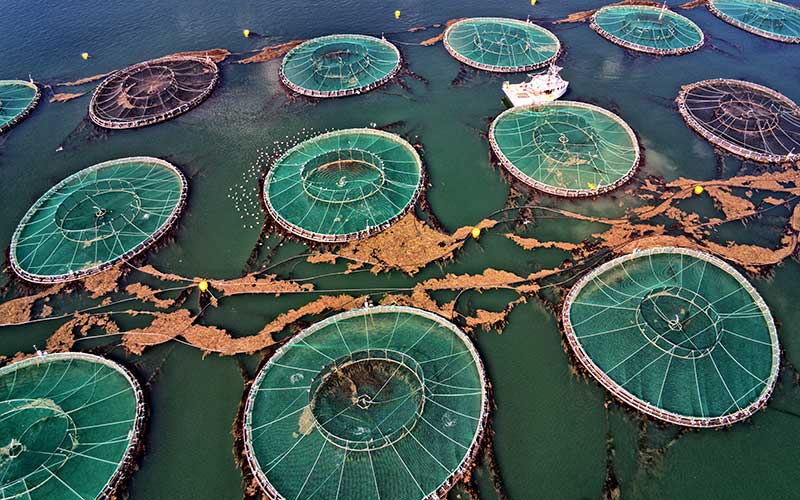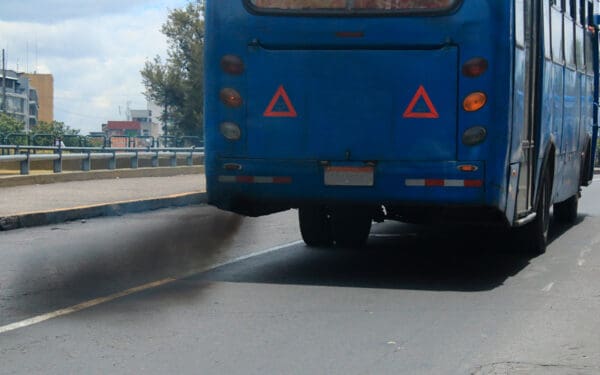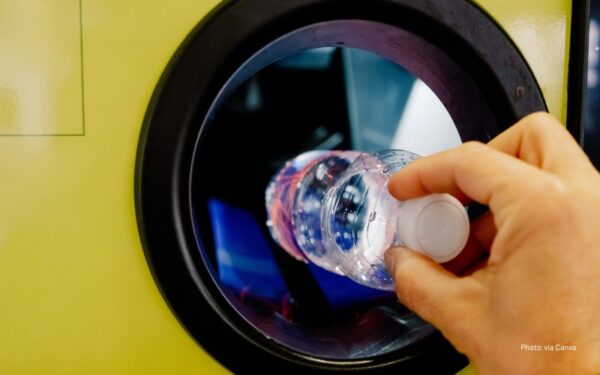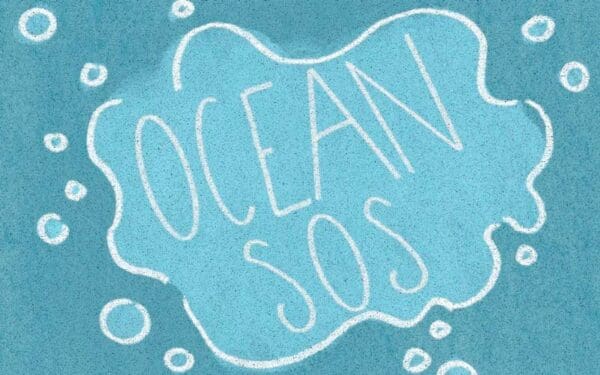
Massive floating salmon pens dump waste directly into Maine's waters. Photo: Shutterstock
This past summer, around 50,000 industrially farmed salmon wriggled free through holes in their pens into the waters of Machias Bay, Maine. It’s possible the farmed fish survived their prison break to spread diseases that thrive in captivity to critically endangered wild salmon out at sea and upstream in the nearby Machias River. Despite this, the escaped fish were not tracked, and Maine did not hold the industry responsible.
With millions of salmon being raised on industrial farms in Maine, we cannot risk another incident like this one. To avoid this and a host of other environmental impacts from these farms, CLF is calling for changes to how state regulators oversee salmon farming.
Industrial Scale Production Means Industrial Scale Pollution
Over the past 30 years, industrially farming salmon in the ocean has become a massive industry. These farms now dot coastlines around the world with their rows of net-covered salmon pens, including in Maine, New Brunswick, British Columbia, Norway, and Iceland.
A “net pen” is like an iceberg: not much is visible from the surface. But beneath the waves, up to hundreds of thousands of fish crowd each floating pen. The fish eat and grow at astounding rates – and defecate. A typical industrial farm of several hundred thousand fish produces around one million pounds of waste annually. That’s roughly the same amount of sewage generated by Maine’s largest city, Portland, in a year.
Yet unlike city sewage, in North American fish farms, the poop is not captured or treated. Instead, it floats out through the pens to pile up on the ocean floor. The waste accumulates over time to form a layer of foul-smelling black sludge that is toxic to small bottom-dwelling creatures. Eventually, the seafloor around an industrial salmon farm will transform into a lifeless landscape.
Fish also produce a lot of nitrogen waste. Nitrogen pollution mixed with warm water creates perfect conditions for toxic algae outbreaks. The algae can grow out of control to form massive red tides that poison any fish, turtles, and shellfish in their path. Nitrogen pollution also clouds the water, blocking eelgrass nurseries on the seafloor from essential sunlight.
This is especially dangerous as the climate crisis heats up our oceans, which worsens outbreaks of toxic algae and eelgrass die-offs.
Industrially Farmed Salmon Are Threatening Their Wild Cousins
When salmon are forced to live packed together in the hundreds of thousands, they are vulnerable. Contagious diseases quickly spread through the penned fish. The salmon industry uses antibiotics to prevent disease, but that increases the risk of antibiotic resistance in humans who consume the farmed fish.
What’s more, small crustaceans, known as sea lice, cling to salmon and eat their skin. In natural conditions, sea lice parasites attach in small numbers, making them a minor issue that doesn’t affect a fish’s health. But in industrial salmon farms, they spread easily between captive fish, covering affected fish with open sores. A severe sea lice infestation can kill entire generations of farmed fish. To control sea lice, the salmon industry has historically used chemical treatments and pesticides – including some that kill crustaceans like lobsters.
Disease outbreaks and sea lice infestations at industrial salmon farms also threaten nearby endangered wild salmon and fish species that are key to fishermen. Viruses and sea lice larvae travel through the water from captive fish to wild fish. Escaped farmed fish - like those 50,000 that wriggled free last summer in Machias - can also transmit disease and parasites.
Weak Regulations Put New England’s Coastal Waters at Risk
Regulators around the world are waking up to the dirty reality of industrial fish farms. Washington state and the province of British Columbia are phasing out ocean net pen farming altogether. And in Europe, countries like Norway strictly regulate industrial salmon farming. They charge high fees and require treatment of the fish poop.
Maine’s fish farm regulations have been lagging behind.
Maine’s open net pen permits do not limit the amount of fish poop or nitrogen the industrial farms can add to the ocean. And the industry is not required to monitor nitrogen pollution levels or most water quality impacts. Annual fees for renting the ocean, a natural resource that belongs to all of us, are extraordinarily low – especially in comparison to fees charged in other countries with more robust fish farming regulations.
With such a sweetheart deal, it’s no wonder Maine attracts industrial fish farms. The state is currently home to 13 industrial salmon farms, and only strong community opposition has so far kept that number from increasing. In 2022, a grassroots coalition won the first round against a massive industrial salmon farm proposed for Frenchman Bay near Acadia National Park that would have produced a staggering 60 million pounds of fish in net pens.
CLF Is Fighting to Protect New England’s Waters from Industrial Salmon Farms
Industrial salmon farming in ocean net pens is a threat to New England’s coastlines and to our ways of life. CLF will be continuing our advocacy to oppose industrial fish farms that endanger the environment. And we will fight for robust regulations that protect our beloved waters and their irreplaceable marine wildlife.
Maine’s Department of Marine Resources is responsible for renting out sections of the ocean to industrial salmon net pen farms. Before they approve a net pen farm, they are supposed to ensure that each farm is in the right location. But in practice, their review of potential farm sites is just a rubber stamp. The Department has approved farms that are too close together, near key fishing grounds over protests from fishermen, and in shallow waters where pollutants are more harmful.
Maine’s Department of Environmental Protection – the agency charged with protecting Maine’s waters – sets no limits on how much waste fish farms can add to the ocean. And it doesn’t even require industry to track how its pollution is affecting the health of the surrounding environment.
CLF wants to see stronger oversight from both Departments. If Maine is going to allow industrial salmon farming in its waters, it needs to minimize the industry’s impacts on the environment. Maine’s DMR is currently requesting comments on their aquaculture policies. Maine residents, make your voices heard!



